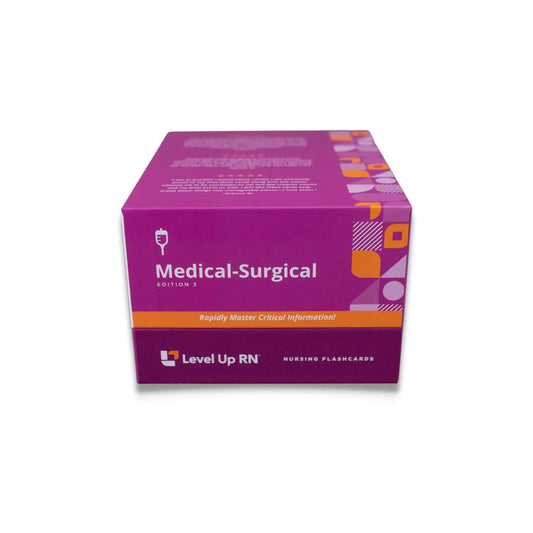Med-Surg - Nervous System, part 14: Cataracts, Glaucoma
Updated: Cathy ParkesCataracts and glaucoma. The pathophysiology, risk factors, signs/symptoms, diagnosis, treatment for cataracts. Patient teaching for patients following cataract surgery. Glaucoma, including open angle and closed angle glaucoma. The pathophysiology, risk factors, signs/symptoms, diagnosis, and treatment of these glaucoma.
Full Transcript: Med-Surg - Nervous System, part 14: Cataracts, Glaucoma
Full Transcript: Med-Surg - Nervous System, part 14: Cataracts, Glaucoma
Hi. I'm Cathy with Level Up Rn. In this video, I am going to be talking about some eye disorders. Specifically, I will be covering cataracts as well as glaucoma. And if you stay till the end of the video, I'm going to give you guys a little quiz to test your knowledge of some of the key points I'll be covering in this video. So definitely stay tuned for that. And if you have our medical surgical nursing flashcards available at LevelUpRn, be sure to pull those out so you can follow along with me.
First up, let's talk about cataracts. A cataract is a lens opacity that impairs vision. So the proteins in the lens will deteriorate as we get older and they clump together, and it causes the lens to thicken and harden, and it creates this opacity. And that lens opacity obstructs the light as it tries to go through the lens to the retina.
So in terms of risk factors, aging is the number one risk factor. Cataracts are very common as we get older. Other risk factors include trauma, a family history, as well as systemic diseases such as diabetes.
In terms of signs and symptoms, the patient will have a gradual, painless loss of vision. They may complain of blurry vision or double vision. As the cataract advances, you may notice that the patient's pupil will appear white or gray in color, and then upon examination, they will have an absent red reflex.
So in terms of diagnosis, we can do this with a physical examination as well as a visual acuity test.
And then the treatment for a cataract is surgical removal of that cataract. That is the cure.
So after the patient has this surgery, we need to provide a number of teaching points to the patient. So after cataract surgery, the patient will need to use a number of eye drops. So they will likely have antibiotic eye drops. They'll have steroid eye drops as well as like NSIAD eye drops, and they're going to need to use these drops several times a day. So you need to reinforce the importance of maintaining that schedule and adhering to the installation of those eye drops.
You also want to advise your patient to wear dark sunglasses when they go outside, and then they need to avoid activities or things that can cause an increase in intraocular pressure. So they need to avoid bending at the waist. They should avoid sneezing, coughing, or blowing their nose. They should not lift anything over 10 pounds, and then they should also avoid straining with bowel movements. In terms of how long it takes to get their best vision. That usually happens around four to six weeks, so it won't be immediately after surgery. You need to give your patient a heads up that it will take a month or more before they obtain that best vision.
Next, we have glaucoma, which is an eye disorder that damages the optic nerve and causes an increase in intraocular pressure, or IOP. So we have open angle glaucoma and closed angle glaucoma.
Open angle glaucoma is more common, and it is caused by aqueous humor overproduction or a decrease in outflow. And this causes a gradual increase in intraocular pressure.
Closed angle glaucoma is less common, and it's caused by forward displacement of the iris So the iris kind of bulges forward, and that closes the angle completely between the iris and the cornea. And this causes aqueous humor outflow to be blocked completely. And this results in a rapid increase in intraocular pressure.
So if you think about a sink that is backed up, if you have some kind of blockage down there but the water is still getting through, then that's like open angle glaucoma. But if you have some kind of blockage in your sink such that water is not getting through at all, then it's all going to back up. And that's like closed angle glaucoma.
In terms of risk factors for glaucoma. Risk factors include aging, genetics, diabetes as well as hypertension.
Signs and symptoms of open angle glaucoma include the loss of peripheral vision. So that's an important one to know for open angle glaucoma. Other symptoms can include mild aching in the eyes, as well as a headache. For closed angle glaucoma the patient will have severe eye pain, which is something we don't have with open angle glaucoma. Other symptoms of closed angle glaucoma can include nausea and vomiting, blurred vision, halos around lights, as well as reddened sclera.
In terms of diagnosis, we would use tonometry to measure a patient's IOP. Normal IOP should be between 10 and 21 MMHG. If the patient has an IOP that is over 21, that may be indicative of glaucoma.
In terms of treatment. We can use Mannitol, which is an osmotic diuretic which rapidly brings down IOP, so it would be most helpful with closed angle glaucoma. We can also use eye drops for open angle glaucoma, and there are many drops that are available. So examples of eye drops include timolol, acetazolamide, brimonidine, travoprost. The list goes on and on. Most of these drops are aimed at decreasing aqueous humor production or improving aqueous humor outflow.
All right, it's time for quiz. I have three questions for you. First question, what eye disorder is characterized by blurred vision, an absent red reflex and a white pupil? The answer is a cataract. Second question, what eye disorder is characterized by severe eye pain and a sudden increase in intraocular pressure? The answer is closed angle glaucoma. Question number three, what eye disorder is characterized by a loss of peripheral vision and a gradual increase in intraocular pressure? The answer is open angle glaucoma.
All right. That's it for this video. We have one more video in our nervous system playlist, so stay tuned for that information.



1 comment
NCLEX student.